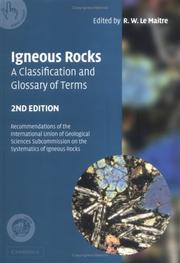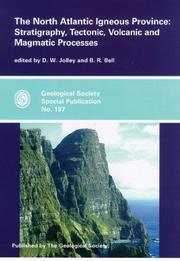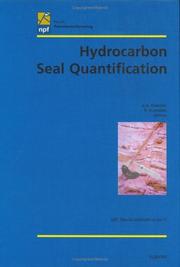| Listing 1 - 10 of 32 | << page >> |
Sort by
|
Digital
ISBN: 9780080538693 008053869X Year: 2002 Publisher: New York Elsevier
Abstract | Keywords | Export | Availability | Bookmark
 Loading...
Loading...Choose an application
- Reference Manager
- EndNote
- RefWorks (Direct export to RefWorks)
Libya has the largest petroleum reserves of any country in Africa and since production began in 1961 over 20 billion barrels of oil have been produced. Libya is scheduled to reach the mid-point of depletion of reserves in 2001 and this provides a timely point at which to review the state of petroleum exploration in Libya. A large amount of data has been published on the geology of Libya, but it is scattered through the literature; much of the older data has been superceded, and several of the key publications, especially those published in Libya, are difficult to find. This book represents the first attempt to produce a comprehensive synthesis of the petroleum geology of Libya. It is based exclusively on published data, supplemented by the author's experience gained during ten years work in Libya. The aim of the book is to systematically review the plate tectonics, structural evolution, stratigraphy, geochemistry, and petroleum systems of Libya, and provides valuable new data on fields, production, and reserves. This volume will provide a ready source of reference to individuals and companies who wish to obtain an overview of the petroleum geology of Libya, and will save them the laborious task of sifting through hundreds of publications to find the data they require. The book includes 148 newly drawn figures.
Book
ISBN: 7108017539 Year: 2002 Publisher: 北京 生活, 讀書, 新知三聯書店
Abstract | Keywords | Export | Availability | Bookmark
 Loading...
Loading...Choose an application
- Reference Manager
- EndNote
- RefWorks (Direct export to RefWorks)
Book
ISBN: 9979321997 Year: 2002 Publisher: S.l. Mál og menning
Abstract | Keywords | Export | Availability | Bookmark
 Loading...
Loading...Choose an application
- Reference Manager
- EndNote
- RefWorks (Direct export to RefWorks)
Book
ISBN: 3443110304 Year: 2002 Publisher: Berlin : Borntraeger,
Abstract | Keywords | Export | Availability | Bookmark
 Loading...
Loading...Choose an application
- Reference Manager
- EndNote
- RefWorks (Direct export to RefWorks)
Igneous rocks --- Orogenic belts --- Petrology --- Rocks, Igneous

ISBN: 1280417676 9786610417674 1139146211 0511169744 0511066511 0511060203 0511323913 1601197462 0511535589 0511068646 9780511066511 9781601197467 9780511535581 9780521662154 052166215X 9780521619486 0521619483 9780521619486 Year: 2002 Publisher: Cambridge : Cambridge University Press,
Abstract | Keywords | Export | Availability | Bookmark
 Loading...
Loading...Choose an application
- Reference Manager
- EndNote
- RefWorks (Direct export to RefWorks)
Decades of field and microscope studies, and more recent quantitative geochemical analyses have resulted in a vast, and sometimes overwhelming, array of nomenclature and terminology associated with igneous rocks. This book presents a complete classification of igneous rocks based on all the recommendations of the International Union of Geological Sciences (IUGS) Subcommission on the Systematics of Igneous Rocks. The glossary of igneous terms has been fully updated since the first edition and now includes 1637 entries, of which 316 are recommended by the Subcommission. Incorporating a comprehensive bibliography of source references for all the terms included in the glossary, this book is an indispensable reference guide for all geologists studying igneous rocks, either in the field or the laboratory. It presents a standardised and widely accepted naming scheme that will allow geologists to interpret terminology in the primary literature and provide formal names for rock samples based on petrographic analyses. It is also supported by a website with downloadable code for chemical classifications.
Igneous rocks --- Geology. --- Geognosy --- Geoscience --- Earth sciences --- Natural history --- Eruptive rocks --- Igneous petrology --- Petrology, Igneous --- Rocks, Eruptive --- Rocks, Igneous --- Rocks --- Petrology --- 552.3 --- 552.3 Magmatic rocks. Igneous rocks --- Magmatic rocks. Igneous rocks --- Classification.

ISBN: 1402008937 Year: 2002 Publisher: Dordrecht : Kluwer academic,
Abstract | Keywords | Export | Availability | Bookmark
 Loading...
Loading...Choose an application
- Reference Manager
- EndNote
- RefWorks (Direct export to RefWorks)
Geodynamics --- Metamorphic rocks --- Metamorphism (Geology) --- Metamorphism (Geology). --- Metamorphic rocks. --- Geodynamics.
Book
Year: 2002 Publisher: Denver, Colo. : U.S. Dept. of the Interior, U.S. Geological Survey,
Abstract | Keywords | Export | Availability | Bookmark
 Loading...
Loading...Choose an application
- Reference Manager
- EndNote
- RefWorks (Direct export to RefWorks)
Rocks --- Spectrum analysis. --- Analysis. --- Spectra.
Book
ISBN: 3443011497 9783443011499 9783443110307 Year: 2002 Publisher: Berlin, Germany ; Stuttgart, Germany : Borntraeger,
Abstract | Keywords | Export | Availability | Bookmark
 Loading...
Loading...Choose an application
- Reference Manager
- EndNote
- RefWorks (Direct export to RefWorks)
Igneous rocks --- Petrology --- Orogenic belts

ISBN: 1862391084 9781862391086 Year: 2002 Publisher: London : The Geological Society,
Abstract | Keywords | Export | Availability | Bookmark
 Loading...
Loading...Choose an application
- Reference Manager
- EndNote
- RefWorks (Direct export to RefWorks)
Geology --- Igneous rocks --- Eruptive rocks --- Igneous petrology --- Petrology, Igneous --- Rocks, Eruptive --- Rocks, Igneous --- Rocks --- Geognosy --- Geoscience --- Earth sciences --- Natural history --- Petrology

ISBN: 9780080534275 0080534279 0444506616 9780444506610 1281057282 9780444505510 9780444505510 9780444505510 9786611057282 Year: 2002 Publisher: New York ; Amsterdam : Elsevier and NPF,
Abstract | Keywords | Export | Availability | Bookmark
 Loading...
Loading...Choose an application
- Reference Manager
- EndNote
- RefWorks (Direct export to RefWorks)
This volume contains 17 selected papers reflecting the flavour of the Norwegian Petroleum Society conference on hydrocarbon seals quantification and showing the recent significant advances in the understanding and application of hydrocarbon seal methodologies. Three broad categories are covered in this book: methodologies addressing cap-rock integrity, methodologies relating to fault seal and case studies both from the hydrocarbon basins of Northwestern Europe and in the form of outcrop examples. With the North Sea, Norwegian Sea and Atlantic Margin moving along their respective basin maturity and development curves, exploration is being forced deeper into high pressure/high temperature terrains, while exploitation and development requires greater precision and realism in reservoir simulations to maximise drilling strategies to prolong field life. In all instances the need for predictive tools and methodologies that address the integrity and behaviour of top and lateral (fault) seals to hydrocarbon traps, both in the static and dynamic state, have been identified as key risk factors and this is reflected in this volume.
Rocks. Minerals --- Traps (Petroleum geology) --- Petroleum --- Geology
| Listing 1 - 10 of 32 | << page >> |
Sort by
|

 Search
Search Feedback
Feedback About UniCat
About UniCat  Help
Help News
News